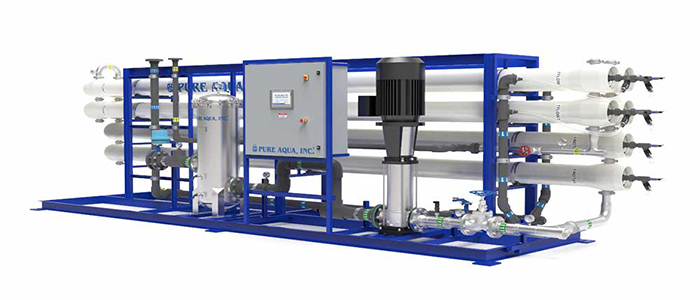
Using physical separation techniques like nanofiltration and reverse osmosis is crucial to remove pollutants from liquids. With recent advancements in affordability and effectiveness, nanofiltration and reverse osmosis technologies have found widespread use in residential, commercial, and industrial settings. This is to help produce potable water as well as treat drinking, seawater, brackish, and wastewater.
How nanofiltration and reverse osmosis are similar
Both nanofiltration and reverse osmosis rely on the pressurization of a flowing liquid. This forces it through a semipermeable membrane, thus removing any dissolved solids. These technologies can remove agricultural chemicals, pesticides, and dissolved organics. This is similar to other types of membrane filtration, like MF and UF, but can handle smaller molecules.
Both reverse osmosis and natural nanofiltration benefit from pretreatment
Because of their small pores, nanofiltration and reverse membranes can quickly become clogged if media filtration, ultrafiltration, or other upstream filtration technologies fail to remove larger particles. Saving energy is another benefit of pretreating process streams. This is to help eliminate these harmful particles. This helps keep the pressure in a nanofiltration and reverse osmosis system at an optimal level.
Low maintenance and long service life requirements are possible with nanofiltration and reverse osmosis membranes when process streams are adequately pretreated. The reason behind this is that the filtration membrane undergoes continuous crossflow filtration. This means that rejected substances are swept away with the waste stream instead of being trapped on the membrane.
Both nanofiltration and reverse osmosis need pressure to function
Energy is necessary to transport water across the nanofiltration and reverse osmosis membranes. These are two relatively efficient purification technologies. The high concentration of salts and other compounds on the retaining side of the membrane due to their fine pores makes it difficult for water to pass through. To overcome this, a sufficient amount of pressure is applied, which the osmotic pressure counteracts.
How nanofiltration and reverse osmosis are different
The size of the particles that nanofiltration and reverse osmosis can reject or remove differentiates the two, although they are otherwise quite similar. Compared to MF and UF, nanofiltration and reverse osmosis can remove finer contaminants. These processes remove organic macromolecules, heavy metals, sulfates, hardness, radionuclides, TDS, and nitrates from waste streams and processes.
Nanofiltration
Compared to reverse osmosis, nanofiltration provides a slightly coarser filtration process, with the capability to eliminate particles with a diameter ranging from 0.002 to 0.005 micrometers. The primary goal of nanofiltration development, a technology still in its infancy, was to generate drinkable water. While reverse osmosis would eliminate more minerals, nanofiltration keeps more dangerous pollutants like organic macromolecules and pesticide chemicals. Modern reverse osmosis systems keep trace amounts of minerals to maintain water’s taste and safety. Smaller monovalent ions, like sodium chloride, can pass through NF membranes, while bigger divalent ions, like calcium sulfate, can’t.
Reverse osmosis
With its incredibly tiny pores that can trap particles as tiny as 0.0001 micrometers, reverse osmosis is the most advanced membrane purification and filtration system currently available. The printing industry is just one of many industries that use reverse osmosis to process water. This helps keep equipment running at peak efficiency. When it comes to removing ions, reverse osmosis membranes are highly effective, regardless of size. Since no other purification or filtration method comes close to matching the cost savings, efficiency, and effectiveness offered by RO systems, they have quickly risen to the position of preferred water purification for both commercial and residential use.
Both are used in place of traditional treatment technologies.
In the event of an industrial application, a typical water treatment train will include multiple unit processes such as filtration, flocculation, clarification, ion exchange, sedimentation, and coagulation. Sedimentation, clarification, ion exchange, filtering, purification, and polishing are the processes involved in residential treatments.
Traditional treatment methods can successfully remove dissolved solids. However, they rely on a lengthy and intricate process that can be costly and resource-intensive. This will require a wide range of chemical agents and specialized equipment. Installing the systems under the sink, in the customer’s basement, or the garage solves this problem. They are also suitable for commercial or residential use.
Nanofiltration and reverse osmosis membrane technologies’ efficiency, affordability, and compact size have led to their increased adoption as more eco-friendly, space-saving alternatives to traditional treatment systems, both in homes and businesses. One example is the elimination of concentrated brine byproducts. Also, several treatment steps are consolidated into one when nanofiltration is used instead of conventional lime softening.
Conclusion
In cases where there’s no liquid discharge, NF, despite its many advantages, might not be the way to go. NF, similar to RO, produces a substantial amount of effluent, sometimes as much as half of the feed volume. In order to prevent discharge, some facilities may choose to utilize injection wells or evaporation ponds.
Water is essential for the operation of many industrial facilities, and NF systems offer a flexible and affordable solution. When planning systems to purify water for industrial use, they need consideration.
